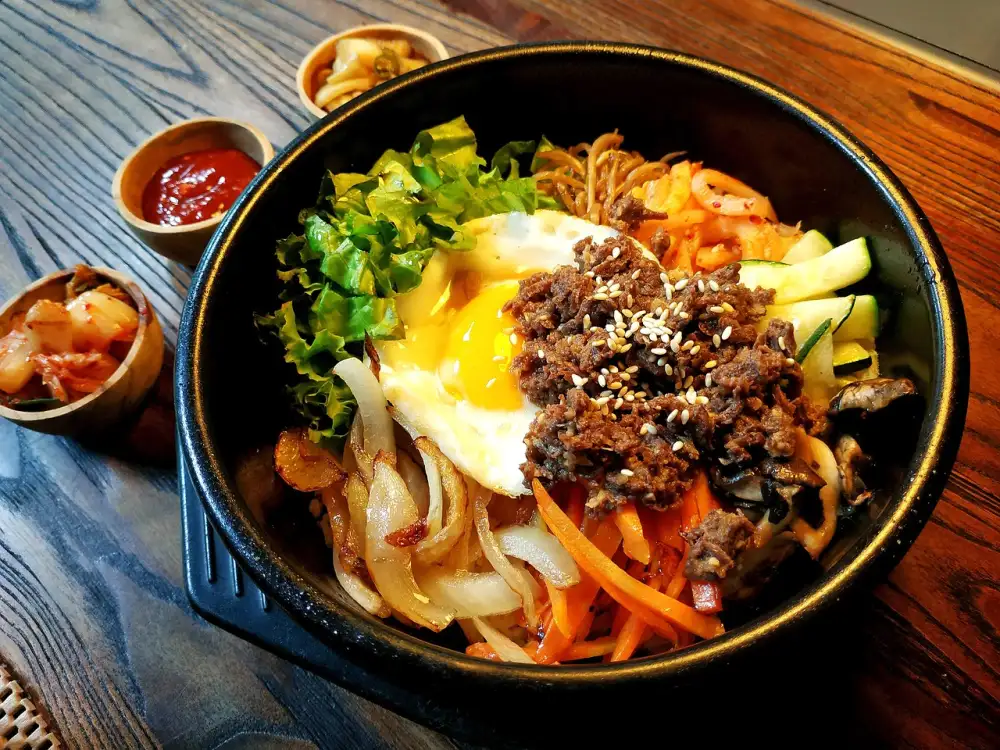Spice Up Your Meals with Gochujang: Unleash the Flavors of this Korean Fermented Condiment - Recipes

- The History and Origins of Gochujang
- Understanding the Ingredients and Fermentation Process
- Health Benefits of Gochujang: A Nutritional Powerhouse
- Gochujang in Traditional Korean Cuisine: Classic Recipes
- Modern Twists: Creative Ways to Use Gochujang in Everyday Cooking
- Gochujang Substitutes: Alternatives for Different Palates
- Tips and Tricks for Using Gochujang in Your Recipes
- Where to Buy Gochujang: Finding Authentic Products
Gochujang, a fiery and flavorful Korean condiment, has been capturing the taste buds of food enthusiasts around the world. This versatile paste adds a unique kick to any dish, elevating it to new levels of deliciousness. Made from fermented soybeans, red chili peppers, glutinous rice, and salt, gochujang offers a complex balance of heat, sweetness, and umami. Whether you're a spice lover or simply looking to add some excitement to your meals, gochujang is sure to ignite your culinary adventures. Get ready to embark on a journey through the vibrant flavors of this beloved Korean staple.
The History and Origins of Gochujang
Gochujang, a spicy Korean condiment, has a rich history and fascinating origins. It dates back to the 16th century during the Joseon Dynasty. Gochujang was first created as a way to preserve red chili peppers and soybeans, which were abundant in Korea. Over time, this fermented paste gained popularity and became an essential ingredient in Korean cuisine. Its unique flavor profile and versatility have made it a beloved staple in Korean households and restaurants alike. Today, gochujang continues to be cherished for its bold taste and ability to elevate any dish it is added to.
Understanding the Ingredients and Fermentation Process
Gochujang is made from a combination of fermented soybeans, glutinous rice powder, red chili powder, and salt. The key ingredient in gochujang is meju, which is a block of fermented soybeans. Meju is traditionally made by boiling soybeans and grinding them into a paste. This paste is then shaped into blocks and left to ferment for several months.
During the fermentation process, enzymes in the meju break down proteins in the soybeans into amino acids, resulting in a rich umami flavor. The fermentation also creates beneficial bacteria that contribute to the unique taste and texture of gochujang.
After the fermentation period, the meju blocks are mixed with glutinous rice powder, red chili powder, and salt. The mixture is then aged for additional months to develop complex flavors.
The length of the fermentation process can vary depending on personal preference and desired taste. Some gochujang producers age their product for as little as three months, while others let it ferment for up to a year or more.
This careful process results in a deep red color and a thick paste-like consistency that adds depth and complexity to dishes. The balance of sweetness from the rice powder, heat from the chili powder, and savory umami flavors from the fermented soybeans make gochujang an essential ingredient in Korean cuisine.
Health Benefits of Gochujang: A Nutritional Powerhouse
Gochujang is not only a delicious condiment, but it also packs a punch when it comes to health benefits. This Korean fermented condiment is a nutritional powerhouse, rich in vitamins and minerals. It contains capsaicin, which has been shown to boost metabolism and aid in weight loss. Gochujang is also high in antioxidants, which help protect the body against free radicals and reduce inflammation. Additionally, it contains probiotics that promote gut health and improve digestion. With its combination of spicy flavor and health benefits, gochujang is truly a must-have ingredient in your kitchen.
Gochujang in Traditional Korean Cuisine: Classic Recipes
Gochujang, the spicy Korean condiment, is a staple in traditional Korean cuisine. It adds depth and complexity to dishes, elevating them to new heights of flavor. Here are some classic recipes that showcase the versatility of gochujang:
1. Bibimbap: This iconic dish features a colorful mix of vegetables, meat (optional), and a fried egg on top of a bed of rice. Gochujang is mixed with soy sauce and sesame oil to create a savory sauce that ties all the ingredients together.
2. Tteokbokki: These chewy rice cakes cooked in a spicy gochujang-based sauce are a popular street food in Korea. The combination of heat from the gochujang and the sweetness from sugar creates an addictive flavor.
3. Jjigae: A hearty stew made with various ingredients such as tofu, pork, or seafood, jjigae gets its rich flavor from gochujang. The fermented condiment infuses the broth with its signature spiciness and umami.
4. Kimchi Fried Rice: Leftover rice is transformed into a delicious meal by stir-frying it with kimchi, vegetables, and gochujang. The result is a satisfyingly spicy and tangy dish that can be enjoyed on its own or as a side.
These classic recipes highlight the versatility of gochujang in Korean cuisine. Its bold flavors add depth and excitement to traditional dishes, making them truly unforgettable culinary experiences.
Modern Twists: Creative Ways to Use Gochujang in Everyday Cooking
Gochujang's versatility extends beyond traditional Korean cuisine, making it a perfect ingredient to experiment with in your everyday cooking. Here are some creative ways to incorporate this spicy condiment into your meals:
1. Gochujang Glaze: Add a kick to your grilled meats or vegetables by creating a gochujang glaze. Simply mix gochujang with honey, soy sauce, and garlic, then brush it onto your food before grilling for a flavorful and slightly spicy twist.
2. Gochujang Mayo: Elevate your sandwiches and burgers by mixing gochujang with mayonnaise. This creamy and spicy spread will give your dishes an extra layer of flavor.
3. Gochujang Stir-Fry Sauce: Create a quick and easy stir-fry sauce by combining gochujang with soy sauce, sesame oil, ginger, and garlic. Toss it with your favorite vegetables and protein for a deliciously spicy stir-fry.
4. Gochujang Marinade: Infuse your meats or tofu with the bold flavors of gochujang by using it as a marinade. Combine gochujang with soy sauce, rice vinegar, sesame oil, and brown sugar for a sweet and savory marinade that will take your dishes to the next level.
5. Gochujang Salad Dressing: Give your salads an Asian-inspired twist by whisking together gochujang, rice vinegar, sesame oil, honey, and lime juice. Drizzle this tangy dressing over fresh greens for a unique and flavorful salad experience.
These modern twists on using gochujang will add depth and spice to your everyday meals while allowing you to explore new culinary horizons. Don't be afraid to get creative in the kitchen and unleash the full potential of this Korean fermented condiment!
Gochujang Substitutes: Alternatives for Different Palates
Gochujang, with its unique flavor profile and spicy kick, may not be everyone's cup of tea. However, fear not! There are alternatives available for those with different palates. If you prefer a milder taste, consider using doenjang, a Korean fermented soybean paste that offers a savory and slightly sweet flavor. Another option is sriracha sauce, which provides a similar level of heat but with a tangy twist. For those looking for a non-spicy substitute, miso paste can be used to add depth and umami to your dishes. Remember to adjust the quantities according to your taste preferences and experiment with these substitutes to find the perfect match for your culinary adventures!
Tips and Tricks for Using Gochujang in Your Recipes
1. Start small: Gochujang is known for its intense heat, so it's best to add a little at a time and taste as you go. You can always add more if needed.
2. Balance the flavors: Gochujang has a unique combination of spiciness, sweetness, and umami. To balance these flavors, pair it with ingredients like soy sauce, honey, or vinegar.
3. Use as a marinade: Gochujang makes an excellent marinade for meats and vegetables. Let them sit in the marinade for at least 30 minutes to allow the flavors to penetrate.
4. Mix into sauces and dressings: Add a spoonful of gochujang to your favorite sauces or dressings to give them a spicy kick. It works well in stir-fry sauces, dipping sauces, or even salad dressings.
5. Stir-fry with gochujang: Heat up some oil in a pan, add your choice of protein and vegetables, then stir in gochujang for a quick and flavorful stir-fry.
6. Spice up your soups and stews: Add gochujang to your soups or stews for an extra layer of flavor and heat. It pairs particularly well with hearty broths and meat-based soups.
7. Experiment with fusion dishes: Gochujang can be used in non-Korean recipes too! Try adding it to tacos, burgers, or even pasta dishes for a unique twist on familiar favorites.
8. Store properly: Keep your gochujang refrigerated after opening to maintain its freshness and flavor. It can last for several months when stored correctly.
Remember, don't be afraid to get creative with gochujang! Its versatile flavor profile allows you to experiment and enhance various dishes in exciting ways.
Where to Buy Gochujang: Finding Authentic Products
When it comes to finding authentic gochujang, there are a few options available. One of the best places to start is your local Asian grocery store or Korean market. These stores often have a wide selection of gochujang brands and variations to choose from.
If you don't have access to an Asian grocery store, you can also try looking for gochujang online. There are many reputable websites that specialize in selling Korean ingredients and products, including gochujang. Just make sure to read reviews and check the authenticity of the seller before making a purchase.
Another option is to make your own gochujang at home. While this may require some time and effort, it can be a rewarding experience. There are plenty of recipes available online that guide you through the fermentation process and help you create your own homemade gochujang.
Remember, when buying gochujang, look for products that list traditional ingredients like red chili pepper flakes (gochugaru), fermented soybean powder (meju), glutinous rice powder, and salt. Avoid products that contain artificial additives or preservatives.
By sourcing authentic gochujang, you can truly embrace the flavors of this Korean condiment and enhance your culinary adventures with its unique spicy and savory profile.
In conclusion, Gochujang is a versatile and flavorful condiment that can elevate any dish. Its spicy and savory profile adds depth and complexity to your meals, making them truly unforgettable. Whether you're exploring traditional Korean recipes or experimenting with modern twists, Gochujang is sure to bring excitement to your culinary adventures. So go ahead, embrace the flavors of Gochujang and let it spice up your meals in ways you never thought possible. Get ready to embark on a delicious journey with this Korean fermented condiment!
Published: 13. 01. 2024
Category: Recipes



